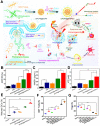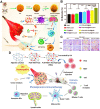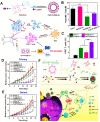Progress in advanced nanotherapeutics for enhanced photodynamic immunotherapy of tumor
- PMID: 35910806
- PMCID: PMC9330533
- DOI: 10.7150/thno.73566
Progress in advanced nanotherapeutics for enhanced photodynamic immunotherapy of tumor
Abstract
Clinically, the conventional treatments of cancer are still often accompanied by tumor recurrence, metastasis and other poor prognosis. Nowadays, more attention has been paid to photodynamic therapy (PDT), which is regarded as an adjuvant antineoplastic strategy with superiorities in great spatiotemporal selectivity and minimal invasiveness. In addition to eliminating tumor cells via reactive oxygen species (ROS), more meaningfully, this phototherapy can trigger immunogenic cell death (ICD) that plays a vital role in photodynamic immunotherapy (PDIT). ICD-based PDIT holds some immunotherapeutic potential due to further enhanced antitumor efficacy by utilizing various combined therapies to increase ICD levels. To help the PDIT-related drugs improve pharmacokinetic properties, bioavailability and system toxicity, multifunctional nanocarriers can be reasonably designed for enhanced PDIT. In further consideration of severe hypoxia, low immunity and immune checkpoints in tumor microenvironment (TME), advanced nanotherapeutics-mediated PDIT has been extensively studied for boosting antitumor immunity by oxygen-augment, ICD-boosting, adjuvant stimulation and combined checkpoints blockade. Herein, this review will summarize different categories of nanocarriers consisting of their material type, targeting and stimuli-responsiveness. Moreover, we will focus on the latest progress of various strategies to enhance the antitumor immune effect for PDIT and elucidate their corresponding immune-activation mechanisms. Nevertheless, there are several thorny challenges in PDIT, including limited light penetration, tumor hypoxia, immune escape and the development of novel small-molecule compounds that replace immune checkpoint inhibitors (ICIs) for easy integration into nanosystems. It is hoped that these issues raised will be helpful to the preclinical study of nanotherapeutics-based PDIT, thus accelerating the transformation of PDIT to clinical practice.
Keywords: immunogenic cell death; nanotherapeutics; photodynamic therapy; tumor immunotherapy.
© The author(s).
Conflict of interest statement
Competing Interests: The authors have declared that no competing interest exists.
Figures










Similar articles
-
Emerging photodynamic nanotherapeutics for inducing immunogenic cell death and potentiating cancer immunotherapy.Biomaterials. 2022 Mar;282:121433. doi: 10.1016/j.biomaterials.2022.121433. Epub 2022 Feb 19. Biomaterials. 2022. PMID: 35202933 Review.
-
A tailored and red-emissive type I photosensitizer to potentiate photodynamic immunotherapy.J Mater Chem B. 2022 Oct 12;10(39):8003-8012. doi: 10.1039/d2tb01578a. J Mater Chem B. 2022. PMID: 36093913
-
Nanomaterials-Based Photodynamic Therapy with Combined Treatment Improves Antitumor Efficacy Through Boosting Immunogenic Cell Death.Int J Nanomedicine. 2021 Jul 8;16:4693-4712. doi: 10.2147/IJN.S314506. eCollection 2021. Int J Nanomedicine. 2021. PMID: 34267518 Free PMC article. Review.
-
In situ immunogenic clearance induced by a combination of photodynamic therapy and rho-kinase inhibition sensitizes immune checkpoint blockade response to elicit systemic antitumor immunity against intraocular melanoma and its metastasis.J Immunother Cancer. 2021 Jan;9(1):e001481. doi: 10.1136/jitc-2020-001481. J Immunother Cancer. 2021. PMID: 33479026 Free PMC article.
-
Smart Nanovesicle-Mediated Immunogenic Cell Death through Tumor Microenvironment Modulation for Effective Photodynamic Immunotherapy.ACS Nano. 2020 Jan 28;14(1):620-631. doi: 10.1021/acsnano.9b07212. Epub 2019 Dec 30. ACS Nano. 2020. PMID: 31877023
Cited by
-
A NRF2 Regulated and the Immunosuppressive Microenvironment Reversed Nanoplatform for Cholangiocarcinoma Photodynamic-Gas Therapy.Adv Sci (Weinh). 2024 Apr;11(14):e2307143. doi: 10.1002/advs.202307143. Epub 2024 Feb 2. Adv Sci (Weinh). 2024. PMID: 38308097 Free PMC article.
-
Recent advances in 2D material-based phototherapy.Front Bioeng Biotechnol. 2023 Mar 3;11:1141631. doi: 10.3389/fbioe.2023.1141631. eCollection 2023. Front Bioeng Biotechnol. 2023. PMID: 36937746 Free PMC article. Review.
-
Global Trends and Research Progress of Photodynamic Therapy in Skin Cancer: A Bibliometric Analysis and Literature Review.Clin Cosmet Investig Dermatol. 2023 Feb 21;16:479-498. doi: 10.2147/CCID.S401206. eCollection 2023. Clin Cosmet Investig Dermatol. 2023. PMID: 36851952 Free PMC article. Review.
-
Smart Polymeric Nanoparticles in Cancer Immunotherapy.Pharmaceutics. 2023 Feb 26;15(3):775. doi: 10.3390/pharmaceutics15030775. Pharmaceutics. 2023. PMID: 36986636 Free PMC article. Review.
-
ROS regulation in gliomas: implications for treatment strategies.Front Immunol. 2023 Dec 7;14:1259797. doi: 10.3389/fimmu.2023.1259797. eCollection 2023. Front Immunol. 2023. PMID: 38130720 Free PMC article. Review.
References
-
- Ng CW, Li J, Pu K. Recent progresses in phototherapy-synergized cancer immunotherapy. Adv Funct Mater. 2018;28:1804688.
-
- Kim J, Cho HR, Jeon H, Kim D, Song C, Lee N. et al. Continuous O2-evolving MnFe2O4 nanoparticle-anchored mesoporous silica nanoparticles for efficient photodynamic therapy in hypoxic cancer. J Am Chem Soc. 2017;139:10992–10995. - PubMed
-
- Wan Y, Fu LH, Li C, Lin J, Huang P. Conquering the hypoxia limitation for photodynamic therapy. Adv Mater. 2021;33:e2103978. - PubMed
-
- Krysko DV, Garg AD, Kaczmarek A, Krysko O, Agostinis P, Vandenabeele P. Immunogenic cell death and DAMPs in cancer therapy. Nat Rev Cancer. 2012;12:860–875. - PubMed
Publication types
MeSH terms
LinkOut - more resources
Full Text Sources
Medical

